Review Alcatel 835 Alcatel OT 835, live pictures
Standard delivery kit
- Phone
- The battery charger
- Manual
- Cable for the synchronization with the PC
- Software

The first “clamshell” from Alcatel was long anticipated for by
the company’s fans, since it contained the highest quality screen
of the whole model-range and a camera not mentioning the new shape
of the phone. In reality the model turned out to be pretty controversial
and just like any ODM-product it has its pluses and minuses. Many
functions do not resemble the ones of the previous Alcatel phones.
The phone in its design is typical for the products of this class;
Alcatel has only added a touch of elegancy to the phone, having
surrounded the camera by the curved lighting indicator. Other than
that, the number of the operation elements on the side, their location
and the external antenna is very usual for this sort of products
(Pantech
G500 for example is almost an identical phone).

A large screen (20x24mm) that you can see on the external panel
recognizes up to 65000 colors (TFT). In my view the quality of the
colors reflected is not very high, the colors are dull. Pantech
G500 for example, has a better colors’ specter (although the presence
of 26200 is claimed, in reality it is 65K only). The advantage of
the external screen of this model is that it allows you to view
the pictures of the calling subscribers or the five seconds in length
videos, which is truly unique. Under the sunrays the screen becomes
very bleak so it is preferable to watch these videos indoors. You
cannot check on the last call or read the messages on this screen.
The only other supplementary function is the activation of the camera
and the preview of the pictures on the external screen.
 

The VGA- camera in the phone, which is to be discussed further,
has a lighting indicator installed around it with several colors
of the backlight that correspond with the different events.

The dimensions of the phone, as well as its weight (of 88grm) are
common for its type (87.7x45.9x20mm). The phone is nicely fitting
for your palm although it is not easy to open with one hand even
with the curvatures on the sides taken into account, you simply
have to get used to opening it.

You can find the headset connector on the upper butt-end, which
is covered by the rubber muffler. On the bottom butt-end you can
find the interface connector that is incongruent with the standard
Alcatel phones. On the side surface there are two volume control
keys and a separate key for the camera activation.

You will uncover a big screen inside that reflects up to 262000
colors according to the developer. LTPS is the technology of the
screen, which actually is an updated version of the TFT technology.
The LTPS abbreviation stands for the low-temperature poly-silicone
display. Its pros, as compared to the TFT-screens, are the quicker
matrix reaction to the command, smaller dimensions, and lesser energy
consumption. At the same time, you can arrange on the hardware panel
not only the screen, but all the operating schemes and the driver
as well. When described on the paper, the capabilities of this technology
look perfect, however the quality of the LTPS display in the Alcatel
835 is far from ideal. The colors of the pictures’ edging on the
screen (the pictures are already installed, you cannot download
the ones of your own) do not look genuine, some are far too bright,
while other are dreary. However, this case of the technological
application is a separate one and the question should rather be
addressed to the manufacturer of these displays. The big as well
as the small matrixes of the LTPS-technology showed on the numerous
exhibitions starting in the year 2002 could be compared for their
quality with the TFT-screens only.
You can read more about the LTPS technology on the http://www.toppoly.com/Toppoly/Technology/LTPS_Tech.asp
website.
It is funny though how the potential of the screen resolution is
higher than the pictures originally installed require it, and the
design of the menu is not very plausible. In several themes the
icons are not very legible, which is also a minus. In the localized
version of the phone the Russian font is traditionally slim, just
like in the other Alcatel phones. This fact makes the Russian messages
and the text typing strongly differ from the standard set of other
languages in the phone.
The resolution of the internal screen is 128x160 pixels (28x36mm),
which allows the screen to read up to five text lines, the information
bar and the captions for the soft keys. Under the sun the screen
strongly specks the light, so in this sense the phone is identical
with all the other phones, there are no distinctions here.
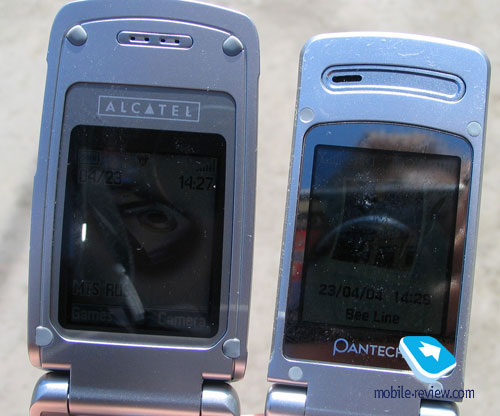
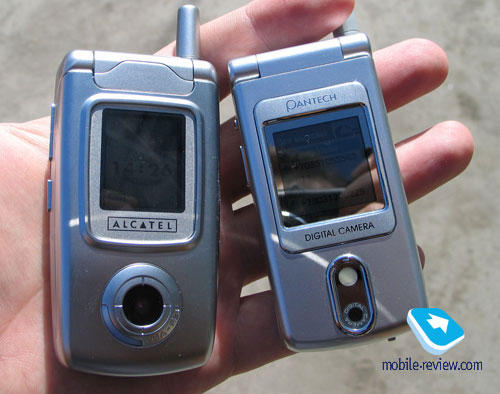
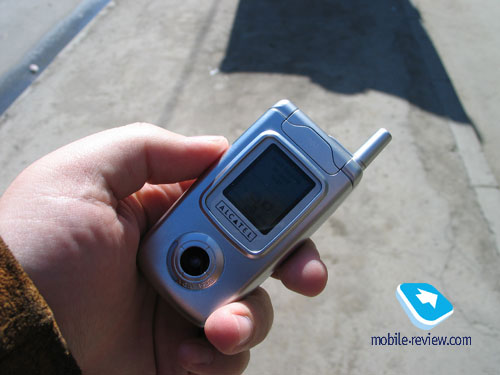
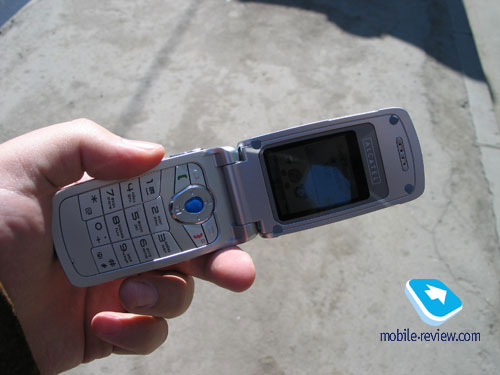
The keypad is designed as a sole block; the big keys are firmly
fixed one by another. The keys’ backlight is pallid and the keys’
signs are not distinguished everywhere; the font is not very big.
The number keys are very convenient although the O’K button installed
within the navigation key is worthy of reproaches. It takes a long
time to get used to this button since you have to be very careful
and accurate pressing it for the mistakes are probable. The majority
of this model’s users took a note of the disadvantages of this key.
The ergonomics of the most recent models is still a weak spot and
unfortunately the phone discussed is not an exception.

The lithium-ionic battery of 785 m capacity is used for this phone.
At the producer’s request it is capable of providing up to 300 working
hours at the stand-by mode and up to four working hours at the talking
mode. The phone worked in the Moscow MTS network three days in case
of 45 minutes of talk and up to 20 minutes of using other functions.
The time of the full charge of the battery is a bit more than two
hours. Overall it can be said that when actively in use, this phone
can work for approximately two to three days.
The SIM-card holder is standard, there are no particularities.

Menu
The main menu is of two kinds; the traditional kind for the majority
of manufacturers is the Mosaic one, which arranges the icons’ rows
in the matrix format. The developers of Alcatel 835 did their best
so that the user could recognize various ways of moving around the
menu; the arrows that show the way of transition surround every
chosen icon. The second kind of the menu array is the Alcatel classical
one - the row of horizontally arranged icons each of which turns
into a big one with a caption when one icon is selected.
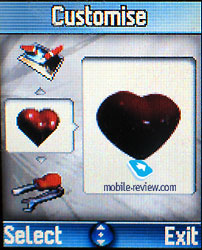 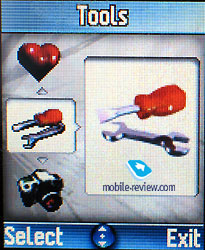

 
There is a possibility of assigning to the soft keys the menu functions
and setting up your own separate menu, which might be convenient
for the functions mostly used. It is also noteworthy that the functions’
calls can be assigned to the number keys instead of speedy numbers’
dialing by one touch. The phone’s voice commands can be used to
access various menu functions.
The voice recognition command does not always work very well; it
becomes essential to enunciate the words and to bring the phone
very close when speaking outdoors. You have to record the voice
tags in the stillness. One of the phone’s particularities is such
that the voice tag might not be recorded at once and then you have
to repeat it several times. The blunder of the current software
in the case above is that sometimes when the tag is being repeated,
the phone warns you that such a tag already exists although when
you quit the menu you find out that the tag has not been saved in
the phone. On the whole, the voice tag function is poorly developed
in this phone as compared to the regular Alcatel phones. For example,
the phone does not invite you with the audio indication to repeat
the voice tag if the recording has failed for the first time. This
means you have to check out the display again.
One of the possible reasons for the sometimes-incorrect performance
of the voice recognition function might be the minimal power of
the phone’s processor and the low speed of the files’ operations.
Consequently, any operation of the data saving, be it a picture
in the maximum screen resolution or the phone book file, is followed
by a slow phone’s thinking process, which certainly takes time.
Obviously the software optimization can add up to ten percent to
the phone’s speed, although the main restraint must be the iron
factor. On the whole, you should keep in mind that most operations
concerned with the data saving would take up some of your time.
The overall memory capacity in the phone is three Mb that are dynamically
shared by all the functions of the phone; for example, by the MMS-messages
and the pictures’ folder.

Phone book. The phone’s memory capacity allows
you to save up to 300 names and indicate for every name such information
as one phone number, one e-mail address, one group of subscribers;
you can also assign to this or that name a picture or a video. To
demonstrate the picture on both ex- and internal screens at the
call is a truly outstanding aspect of this phone. The fact that
you can use both a picture and a video stands for another unique
feature of the phone.
 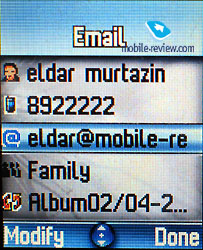
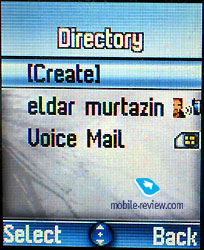 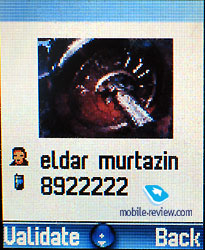
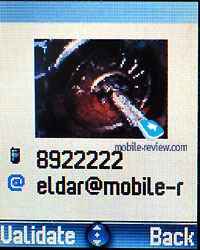 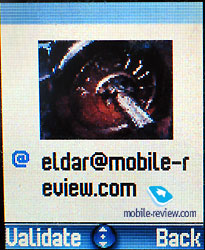
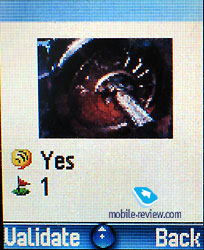 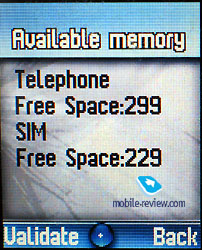
 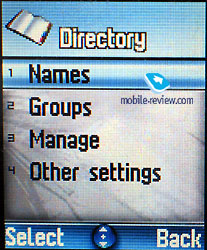
You can do a search in the phone book by the first letter of the
name. Some groups of phone subscribers can select not only their
own melodies, but also their Photo Calls. In the last case, the
group picture or a video will be demonstrated only if the subscriber
does not have his/her own Photo Call. On the other hand, if the
subscriber does have his/her own Photo Call, it will be displayed
instead of the group picture.
Taken as a whole, the phone book in this phone gives way practically
to any phone in its class and can be called pretty unadorned if
the possibility of video assigning is disregarded..
Messages. There are standard samples for the SMS
and the range of pictures for the EMS is not very large- they are
black and white emoticons. When you type in the text, you can choose
to work with the T9 dictionary or without it, it is all very typical.
 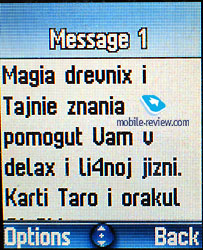
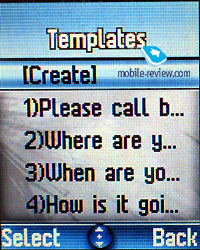
Working with MMS does not generally cause any inconveniences, it
is possible to create several pages and to add up various files.
There is a separate function for the voice MMS messages that is
also the one for the type recorder recordings and their deliveries.
The disadvantage here is the time of the recording limited to ten
seconds with no single moment provided before the start of the recording
after the entrance to this menu function.
Games. The phone is equipped with four games:
Space War, Wall Breaker, Ocean, and Mine. The first game is the
classical arcade; the second one is the great version of the Brick
game (it is a pity that there are not that many levels, they are
repetitive). The third game is the under-the-sea hunting, while
when choosing the fourth, you play the minor game, just like in
the PC. The disadvantage of the games’ arrangement is the different
operating system for each. For example, to start the first game
you have to press the number keys and by no means the navigating
key or the O’K button.
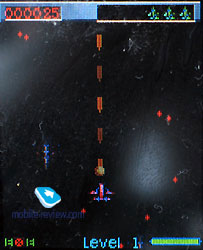 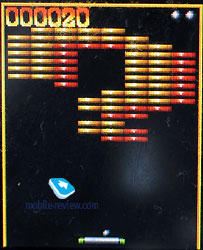
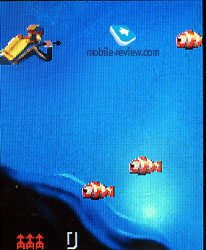 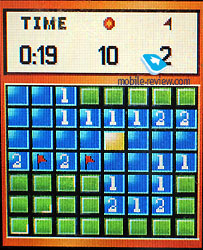
Services. Here you can find the SIM-menu and the
guidelines for the news from the Alcatel Company. On the whole,
nothing of great significance hides in here.
WAP. The browser in the phone is of 1.2.1 version;
there are no “buts” to be mentioned about it.
Tools. The alarm clock, or the alarm clocks rather
can be found here. There might be up to four of them in the phone,
each of which can be set for a single, an everyday, or from Monday
to Friday or from Friday to Monday mode off time. You can also choose
your own melody for the alarm clock.
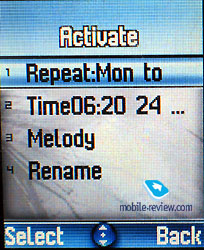
 
The calculator is simple, without any particularities.
The organizer allows you to check out the calendar for a week with
the days divided up by hours or for a month. You can look up the
heading for all the events; the event is described in details when
you choose to enter it. For some of the events you can set the starting
that will go off five minutes before of after it (the self-set time
period is available in hours only). There is a possibility to create
a list of repetitive events. There is no switch to the spontaneously
chosen date; you have to gradually go through the calendar by hand.
The automatic removal of the events occurs after the end of the
indicated period of time. By and large, the organizer is not outstanding
for its capabilities.
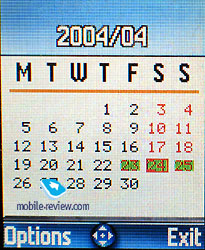 
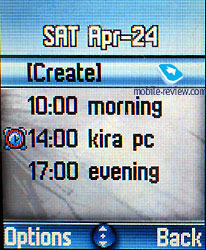 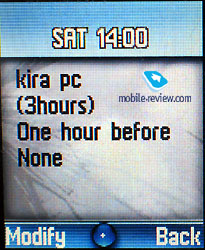
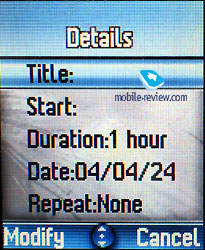
Call list. There are three call lists here, each containing up
to ten files. Only the number is indicated on the list, to view
the date and the time, you have to enter the file.
Voice memo. The phone can record up to ten sound seconds; there
is a separate function to tape the memos, recorded during talks
(the phones of both subscribers provide the recordings).

Personalization. Here you can choose a ring tone,
a message melody (there are voice ones, which are pretty peculiar).
The phone is powered with miscellaneous ring mode-the vibrator and
the melody functioning together.
Atmosphere-the theme variation when you can design a menu of your
own arrangement, and the screen savers as well. Now the new phone
assistants are the characters who garnish the three of the dialogue
windows. There is no particular significance of this function, but
it adds uniqueness to the phone.
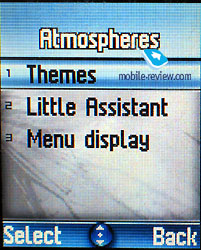
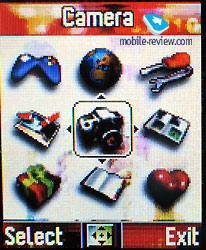
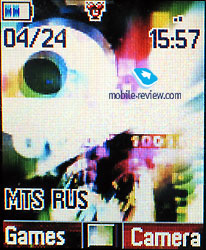 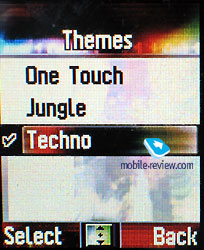
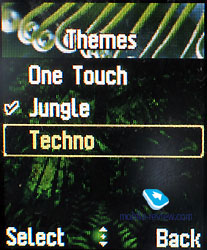 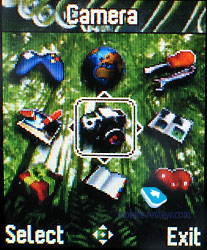
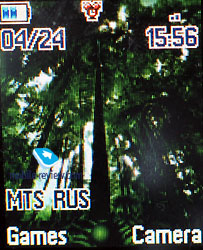 
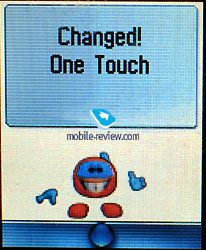 
The other noteworthy functions are the automatic key lock and the
automatic power on/off function .
Camera. The phone’s VGA-camera allows you to take
pictures of the 128x96, 128x160, 320x240 and 640x480 pixels screen
resolution. There also are filters for the different lighting conditions.
Automatically wise the camera is working satisfactorily. The only
“but” that has to be mentioned here is the time of several seconds
that you have to give to the camera so it automatically adopts itself
to the lighting conditions, so the quality of the picture is better.
Pictures taken in the summer time stand for the lower quality. Other
than that, this camera is one of the best in its group.
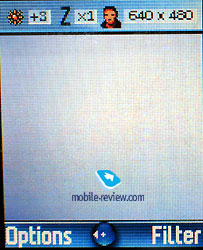 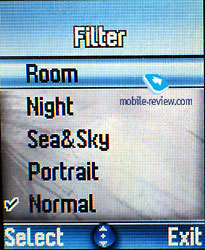
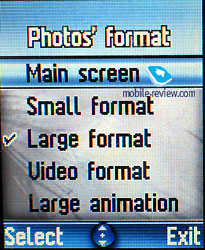
For the formats smaller than the maximum one, the digital zoom
is available. It should be also said that with the screen resolution
of 128x96, 128x160 pixels you can record an animation combined of
up to ten different pictures. You simply have to keep on pressing
the record key, so that the phone starts recording a series of pictures.
The picture on the display at the motion mode becomes blur (as different
from the pictures as such), so you have to keep an eye of what is
being recorded.
Three different dimensions and quality types are available for
the pictures. Clearly all the pictures that come out are of the
JPEG resolution. You can do a timed shooting.



The pictures can be as well taken when the phone is closed; you
just have to press the side key. The picture on the external screen
is of high quality, although when exposed to the sun, the display
fades out, so it is slightly problematic to take the pictures of
yourself in the sunny weather. At this mode, the camera switches
off when you open the phone.
The video is recorded in the MJPEG format, with the video resolution
of 128x96 pixels. The maximum durability of the video is only five
seconds. I am not the one to judge how much in demand this function
is, all I can say that this function is mostly a toy, a sort of
the animated kaleidoscope.
A VGA
picture sample
A
video (100kb, AVI) sample
Multimedia album. In this album all files as well
as the melodies, pictures and videos are saved. The preview of the
pictures can be done in two ways: you can view them as thumbnails
or else as simply icons. You can save the picture as the wallpaper
right away as you view it or you can assign it to the name in the
phone book or to the group of the phone subscribers. The pictures
on the screen look pretty decent although the colors are traditionally
dreary, which is typical for all the phones of the similar optics.
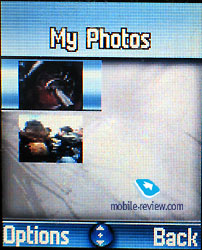 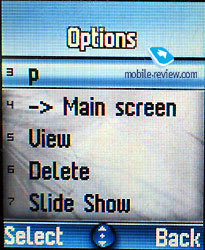
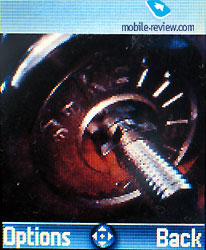 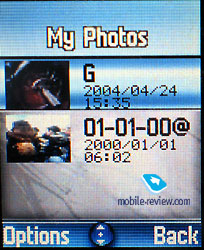
Impressions
When the connection is concerned, the phone works well and there
are no problems with it. The sound of the 40-tone polyphonic ring
is moderate; it can be compared with the sound of the majority of
similar phones. The ring is well heard indoors, and the set of various
melodies is very nice. The vibrator is a bit higher than of moderate
force; it undoubtedly differs from the traditional Alcatel models.
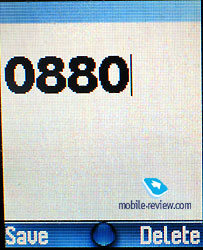 

The handsfree is finely worked out in this phone; the sound of
the speakers is almost always sufficient.
It is pretty easy to distinguish the pluses and the minuses of
the phone. The option to assign videos to the phone book files should
be noted among phone’s advantages while the quality of those videos
and the phone book itself should be considered as minuses. In general,
the offered set of functions leaves much to be desired. For example,
the quality of the internal display is such, that there is no way
to recognize it capable of reflecting 262K colors, I would say 65K
at most and only if projected on the cSTN-screen. That is an obvious
disadvantage of the LTPS-technology; it does not provide the results
the TFT-screens would.
The fact that the ergonomics is not devised to its maximum and
the O’K as well and the navigation keys are inconvenient, adds to
the minuses of the phone. The lack of the IrDA makes the presence
of GPRS class 10 not necessary at all for those ones who are used
to plugging their notebook to the network using the cell phone.
The missing of Java would certainly also have impacts on the users’
choice of this phone.
The cable for the synchronization with PC originally comes with
the phone’ delivery kit, so there is a possibility to synchronize
all data granted that the software is traditionally pretty decent.
Taking into account the fact that the phone came out in the mid-May
with a price of approximately 300-330 dollars, it can be claimed
that this phone shall not become the blockbuster of the season.
The phone of this class is not worth its pricing; the cost should
be no more than 260-280 dollars at the moment of entering the market.
For example, the choice between Alcatel
835, and Pantech
G500, which resembles a lot the last one both in its design
and the described features, would certainly be in favor of Pantech
G500 especially when considering the similar prices.
It is a pity to acknowledge that the first Alcatel “clam shell”
turned out to be a pretty misbalanced product. It is essential to
keep in mind, that this phone is not of Alcatel development, it
is an ODM-product. Everything above being said, we should anticipate
a quick price decrease of this phone, since the demand for it is
not to be very high.
Eldar Murtazin (eldar@mobile-review.com)
Translated by Maria Kapustina (maria@mobile-review.com)
Published — 22 June 2004
Have something to add?! Write us... eldar@mobile-review.com
|




































































